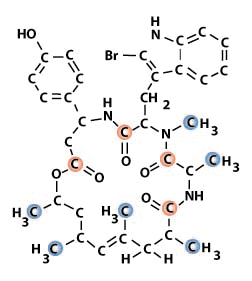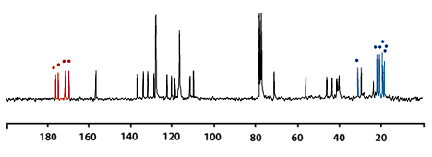



Solve a chemical structure from the edges inward.
The oceans contain an abundance of novel chemicals for chemists to explore. After collecting these molecules from the deep, Phil Crews and other chemists enjoy deducing chemical structures. The detectives gather data and solve the chemical puzzles to produce a ball and stick representation of a molecule previously unknown to science.
Although each chemical structure must be solved anew, researchers use a few standard techniques to cast the larger puzzle pieces. Crews and his colleagues push the chemicals through different machines, each one spitting out new information about the molecules. A mass spectrometer, for example, measures the molecular weight of a chemical. Based on this number, the researchers determine which atoms, and how many of them, contribute to the molecule. For instance, Crews's team found that the toxic chemical from the bright orange rubbery sponge Jaspis Johnstoni contained a whopping 36 carbons, 45 hydrogens, six oxygens, four nitrogens and one bromine atom. Determining the final structure of jasplakinolide took 6 months of laboratory detective work.
Fitting the data together into a single chemical structure requires a good strategy. "It's like we have a bunch of puzzle pieces together, but we can't see the whole molecule," Crews says. To visualize the larger structure, the team uses a car-sized magnet called a nuclear magnetic resonance (NMR) spectrometer to learn which atoms lie next to each other in a given molecule. With the NMR spectrometer, Crews learns whether a carbon sits close to an electron-greedy oxygen atom or whether several hydrogen atoms, instead, surround the carbon.

He looks at the spikes in the NMR spectrum for clues and begins assembling each new puzzle using familiar tricks. "I like to start at the edge of the molecule and work in," he says. To a chemist who has solved more than 500 such puzzles, the edges are instantly identifiable. Clusters of atoms, such as the carbon and hydrogens that make up a methyl group or the carbon and oxygen that make up a carbonyl group, leave identifiable hallmarks in the NMR spectrum.
After assembling a new structure, Crews says, "you sit and think about it and look at it." He trots out a list of questions with which he approaches the new structure. Is this chemical or a related one found in taxonomically related sponges? If the chemical kills cancer cells, then a related chemical might make an even better assassin. But despite the gravy of potential cancer therapies that add flavor to his work, Crews, who is first and foremost a chemist, is happy simply solving puzzles. For Crews, deducing the chemical structure of a previously unknown molecule is an end in itself.

The nuclei of carbon atoms behave like tiny magnets. When an electron-greedy oxygen atom bonds to carbon, it alters carbon's magnetic environment. Carbon atoms bonded to oxygen atoms appear at the left of the spectrum. Hydrogen atoms are not elevtron-greedy, and carbons bonded to them appear at the right.



